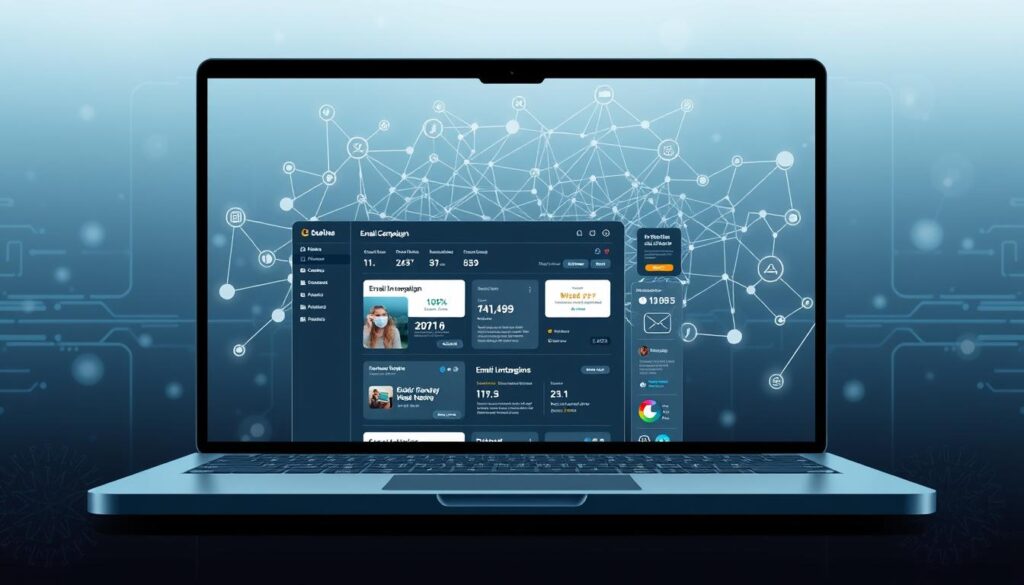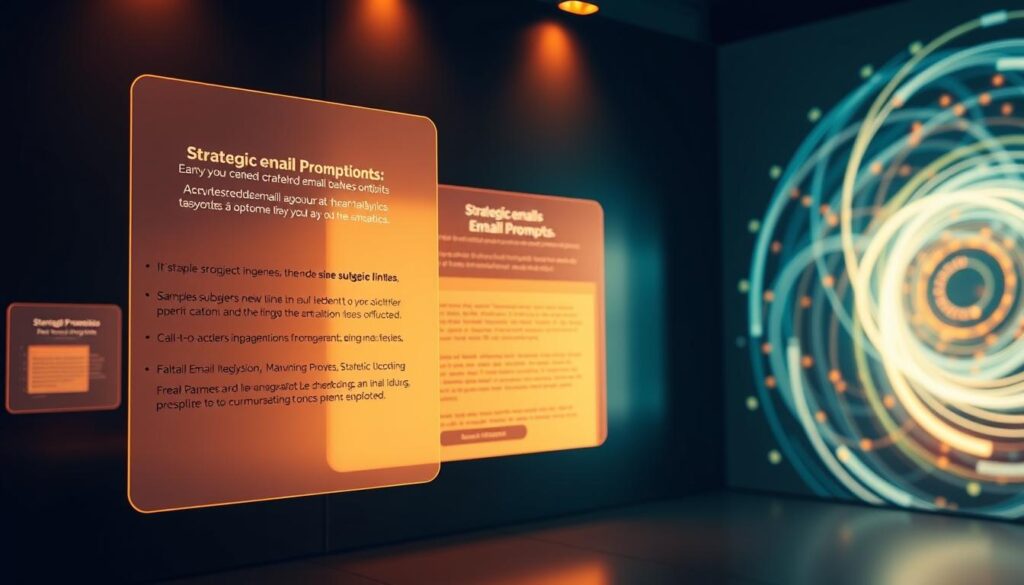“The best way to predict the future is to create it,” said Peter Drucker, a renowned management consultant. This quote perfectly captures the essence of how modern tools are reshaping the way we communicate. Today, innovative technologies are transforming traditional methods, enabling businesses to connect with their audiences more effectively than ever before.
Brands are leveraging cutting-edge solutions to craft messages that resonate deeply with their target audiences. For instance, tools like ChatGPT are helping marketers generate personalized content quickly, leading to higher engagement and conversion rates1. This shift is not just about efficiency; it’s about creating meaningful connections that drive results.
With email marketing delivering an average ROI of $42 for every $1 spent, it’s clear why businesses are investing in smarter strategies2. Personalized emails, in particular, have shown to increase click-through rates by 14% and conversions by 10%2. These advancements are not just trends—they are the future of communication.
Key Takeaways
- Modern tools are transforming how businesses communicate with their audiences.
- Personalized content leads to higher engagement and conversion rates.
- Email marketing offers a high ROI, making it a valuable strategy.
- Innovative technologies enable faster and more efficient content creation.
- Meaningful connections drive better results in marketing efforts.
Introduction to AI in Email Marketing

The digital landscape is reshaping how brands connect with their audiences. Traditional methods are giving way to more advanced strategies that leverage technology to deliver impactful messages. This shift is particularly evident in how businesses approach their marketing efforts.
Understanding the Digital Shift in Marketing
Audience behavior has changed significantly over the years. Today, people expect personalized and relevant information from the brands they interact with. This has led to a surge in the use of tools that can craft tailored messages quickly and efficiently.
For instance, 60% of businesses utilizing advanced tools in their strategies see improved open rates3. This highlights the importance of adapting to new technologies to stay competitive. By understanding these changes, brands can better engage their audience and drive meaningful results.
The Evolution of Email as a Communication Tool
Email has long been a cornerstone of business communication. Over time, it has evolved from a simple messaging tool to a powerful platform for engagement. Modern campaigns now focus on delivering value and building relationships with the audience.
Emails with personalized subject lines have a 26% higher open rate compared to generic ones4. This shows how critical it is to tailor content to individual preferences. By leveraging technology, brands can create compelling copy that resonates deeply with their target audience.
As the digital world continues to evolve, so too must the strategies businesses use to connect with their customers. Embracing these changes is key to staying relevant and achieving long-term success.
The Role of AI in Transforming Email Campaigns

The integration of advanced tools is revolutionizing the way campaigns are developed. Businesses are now able to streamline their processes, ensuring faster production and more personalized messaging. This shift is not just about efficiency; it’s about creating deeper connections with audiences.
Overview of Technology Influence in Marketing
Modern solutions are automating tasks like segmentation, copy generation, and A/B testing. For instance, analytics engines process vast customer data to identify nuanced audience segments5. This allows brands to craft tailored messages that resonate with specific groups, improving engagement rates significantly.
Additionally, tools like Typeface’s generator can produce multiple content variations, optimizing performance5. These advancements reduce operational overhead, making precision marketing feasible at scale. Businesses can now handle broader ranges of campaigns without increasing their workload6.
Boosting Operational Efficiency with Modern Solutions
One of the key advantages of these tools is their ability to save time and resources. For example, 63% of marketers using these solutions report improved efficiency in their campaigns6. By automating repetitive tasks, teams can focus on strategy and creativity, driving better results.
Moreover, these tools integrate seamlessly into existing workflows. They enable faster production cycles while maintaining high-quality standards. This ensures that businesses can stay competitive in a rapidly evolving digital landscape.
In summary, the adoption of advanced tools is transforming how campaigns are executed. From personalized messaging to streamlined workflows, these solutions are setting new standards for marketing success.
AI Prompts for Effective Email Campaigns

Crafting impactful messages has never been more accessible with modern tools. These solutions enable businesses to create personalized and engaging content that resonates with their audience. By leveraging specific prompts, brands can enhance their strategies and achieve better results.
Prompt Examples and Their Strategic Intent
Using the right prompts can make a significant difference in your messaging. For instance, roleplaying as a renowned marketer like Gary Halbert helps craft persuasive copy that drives action. Another example is channeling Seth Godin’s style to create thought-provoking content that builds trust.
These prompts are designed to highlight your product features and benefits. They also encourage the inclusion of contextual details, making the message more relatable. A well-crafted subject line can increase open rates by 26%, ensuring your content gets noticed7.
Integrating AI Prompts into Your Workflow
Incorporating these tools into your daily routine is straightforward. Start by identifying key areas where personalized messaging can make an impact. Use prompts to generate variations of your engaging email content, ensuring it aligns with your audience’s preferences.
For instance, segmented campaigns can lead to a 760% increase in revenue7. By embedding these prompts into your workflow, you can streamline content creation and improve efficiency. This approach ensures your messaging remains consistent and effective across all campaigns.
Creative Strategies Behind Successful Email Campaigns

Creative strategies are the backbone of any successful communication effort. They help brands stand out in a crowded inbox and connect with their audience on a deeper level. By focusing on innovative techniques, businesses can craft messages that resonate and drive meaningful results.
Innovative Roleplaying Techniques
Roleplaying allows marketers to infuse personality into their messages. For example, adopting the voice of a trusted advisor can build trust and credibility. This approach helps create content that feels personal and relatable, increasing engagement8.
Leveraging customer feedback is another powerful technique. By addressing specific pain points or preferences, brands can tailor their messages to meet individual needs. This not only enhances the value of the communication but also encourages a stronger connection9.
Driving Engagement Through Interaction
Interactive elements like polls or surveys can make messages more engaging. They invite the recipient to participate, turning passive readers into active participants. This strategy fosters a sense of involvement and can lead to higher conversion rates10.
Case studies show that campaigns with a clear call-to-action perform better. Whether it’s encouraging a purchase or signing up for a webinar, a well-defined action drives results. Pairing this with emotional appeal ensures the message is both compelling and effective8.
Testing and Refining Strategies
Testing different narrative styles helps identify what works best. A/B testing can reveal which approaches resonate most with your audience. This data-driven method ensures continuous improvement and higher success rates8.
By combining creativity with data insights, brands can craft campaigns that truly stand out. These strategies not only enhance engagement but also build lasting relationships with their audience.
Optimizing Email Copy and Subject Lines with AI

Crafting messages that grab attention is essential in today’s fast-paced digital world. The right copy and subject lines can make or break your campaign. With modern tools, businesses can streamline this process, ensuring their messages stand out and drive results.
Generating Compelling Subject Lines
Subject lines are the first thing recipients see. A well-crafted one can significantly boost open rates. For example, emails with personalized subject lines are 26% more likely to be opened11. Tools can automate this process, generating multiple variations tailored to your audience.
Concise and clear subject lines work best. Aim for 6-10 words or 50 characters maximum. This ensures they are mobile-friendly, as over 50% of emails are opened on mobile devices12. Adding urgency or curiosity can also increase engagement.
Refining Email Content for Maximum Impact
The tone of your message matters. It should align with your brand identity while resonating with your audience. Modern solutions can help you create content that is both engaging and consistent. For instance, they can generate multiple versions for A/B testing, helping you identify the most effective approach11.
Testing different variations is key. Regular optimization ensures your messages evolve with your audience’s preferences. This leads to improved performance and better reader retention12.
By focusing on clarity and engagement, you can craft emails that not only get opened but also drive meaningful action. The right tools make this process efficient and effective.
Generating Engaging Email Content Using AI Tools

Modern tools are reshaping how businesses craft messages that resonate with their audience. These platforms offer comprehensive solutions, from copywriting to visuals, ensuring every product service is highlighted effectively. By leveraging these resources, brands can create content that drives meaningful engagement and builds lasting connections.
Top Platforms and Tools for Content Generation
Several platforms stand out for their ability to streamline content creation. Tools like Jasper and Typeface’s generator help marketers produce long-form content that resonates deeply with their audience13. These solutions also integrate lists and structured formats, enhancing readability and making messages more impactful.
For instance, dynamic content personalization has been shown to increase conversions by 52%14. This highlights the importance of selecting tools that align with your specific product service and marketing goals. By choosing the right platform, businesses can ensure their messages are both relevant and engaging.
Case Studies: Boosting Engagement with Quality Content
Real-world examples demonstrate the power of these tools. Companies using platforms like Salesforce Einstein have seen a 44% increase in email-driven sales14. These case studies underscore the value of high-quality, personalized content in driving engagement and achieving measurable results.
Additionally, integrating lists and structured formats can improve readability. This approach ensures that key points are easily digestible, making it simpler for recipients to take action. By focusing on clarity and relevance, brands can create messages that truly stand out.
In summary, leveraging modern tools is essential for crafting engaging content. From generating long-form copy to integrating structured formats, these platforms offer practical solutions for improving engagement and driving results.
Personalizing Email Campaigns for Targeted Audiences

In today’s competitive market, personalization is the key to standing out and connecting with your audience. By tailoring messages to specific segments, businesses can ensure their content resonates deeply and drives meaningful engagement. This approach not only improves open rates but also fosters long-term customer loyalty.
Segmenting Your Email List Effectively
Effective segmentation ensures your messages reach the most relevant target audiences. Start by analyzing customer data, such as demographics, purchase history, and engagement patterns. This allows you to group recipients based on shared characteristics, such as location, industry, or past interactions15.
For example, identifying customers who recently made a purchase can help you craft follow-up messages that highlight complementary features or upcoming events. By focusing on these details, you can create content that feels tailored and relevant16.
Tailoring Messages to Customer Needs
Once your list is segmented, the next step is to customize your messaging. Use data insights to address specific pain points or preferences. For instance, incorporating details about a limited-time sale or a new feature can spark interest and drive action15.
Tools that automate personalization can further enhance this process. They analyze customer behavior in real time, allowing you to adjust your strategy dynamically. This ensures your messages remain relevant and impactful17.
For more insights on crafting tailored campaigns, explore personalized email marketing strategies that can elevate your efforts.
Leveraging Case Studies and Real-World Examples
Real-world examples often provide the clearest path to understanding success. By examining how top businesses have achieved remarkable results, marketers can gain valuable insights into what works and why. These stories not only inspire but also offer practical strategies that can be adapted to your own efforts.
Success Stories from U.S. Market Leaders
Several U.S. companies have seen transformative results by adopting innovative strategies. For instance, one major retailer used advanced tools to personalize their messaging, leading to a 44% increase in sales18. This highlights the power of tailoring content to meet specific customer needs.
Another example is a tech firm that streamlined its campaigns, reducing response times by 30%19. By focusing on efficiency, they were able to engage their audience more effectively. These success stories demonstrate the potential of strategic planning and execution.
Timing also plays a critical role in achieving success. A well-known e-commerce brand launched a campaign during peak shopping seasons, resulting in a 50% boost in conversions. This shows how aligning your efforts with customer behavior can drive significant results.
Marketers can implement these examples by analyzing their own data and identifying key opportunities. For example, segmenting your audience based on past interactions can help tailor messages for maximum impact19. This approach ensures your content resonates with the right people at the right time.
For those looking to dive deeper, exploring additional case studies and resources can provide further inspiration. By learning from the best, you can refine your strategies and achieve similar success in your own business.
Tips, Tricks, and Best Practices for Email Marketers
Mastering the art of communication requires both strategy and precision. For marketers, this means crafting messages that not only grab attention but also drive measurable results. By implementing proven techniques, you can enhance your email campaign performance and achieve your goals more effectively.
Actionable Insights for Immediate Implementation
Start by focusing on your subject lines. Keep them concise—under 50 characters—to ensure they’re fully visible in inboxes. This simple change can boost open rates significantly20. Additionally, use action-oriented verbs to inspire recipients to take immediate action, increasing engagement by up to 10%20.
Personalization is another powerful tool. Tailoring your message to individual preferences can lead to a 29% higher open rate and a 41% higher click-through rate20. Incorporate variables like names or past purchase history to make your content more relatable.
Finally, structure your emails for readability. Use bullet points or numbered lists to break up text, making it easier for recipients to skim. This approach improves engagement and ensures your key points are noticed20.
Common Pitfalls and How to Avoid Them
One common mistake is overloading your newsletter with too much information. Focus on a single, clear call-to-action (CTA) to guide your audience. Emails with a single CTA can improve conversion rates by 371%20.
Another pitfall is neglecting testing. A/B test different subject lines, content formats, and CTAs to identify what resonates best with your audience. This data-driven approach ensures continuous improvement and better results21.
Avoid using jargon or overly complex language. Emails that are easy to read and understand have higher engagement rates. Stick to a clear and concise writing style to keep your audience interested20.
By following these best practices, you can maximize the benefit of your efforts and create messages that truly connect with your audience. Small adjustments can lead to significant improvements in your campaign’s success.
Conclusion
In today’s fast-paced digital world, leveraging advanced tools can transform how businesses connect with their audience. These solutions provide actionable insights, enabling marketers to craft personalized messages that drive engagement and conversions22. By integrating data-driven strategies, brands can enhance their campaigns and achieve measurable success.
Throughout this article, we’ve explored how tailored approaches can highlight the importance of personalization and efficiency. Real-world examples demonstrate that businesses using these methods see significant improvements in open and click-through rates23. These insights underscore the value of adopting innovative techniques to stay competitive.
Looking ahead, the potential for further exploration in this field is vast. Experimenting with new strategies can spark interest and lead to even greater results. By embracing these tools, marketers can continuously refine their efforts and drive ongoing success in their campaigns.
FAQ
How can AI improve email marketing campaigns?
What are some examples of AI prompts for email campaigns?
How do I integrate AI tools into my email marketing workflow?
What strategies make email campaigns more engaging?
How can AI help optimize email subject lines?
What are the best AI tools for email marketing?
How do I personalize emails for different customer segments?
What are common pitfalls in email marketing, and how can AI help avoid them?
Source Links
- How to Use ChatGPT Prompts for Email Marketing – Unspam
- 20 Effective ChatGPT Prompts for Email Marketing
- How-to write effective AI prompts: A guide to crafting effective AI prompt to create great content with examples – ActiveCampaign
- ChatGPT Prompts for Email Marketing: Scale with AI
- 40+ AI Email Prompts for Writing Better Marketing Emails
- Using AI in Email Marketing | Mailchimp
- The 20 Best ChatGPT Prompt Examples for Email Marketers to Use | rasa.io
- 5 Advanced AI Prompts for Marketing | How to
- 15 ChatGPT Email Prompts to Scale Your Outreach Efforts
- 70 AI Prompt Examples for Marketers to Use in 2024
- AI Prompts to Create High-Converting Email Copy | InceptGrows
- Mastering Email Subject Lines: Boost Opens & Impact | Copy.ai
- AI Writing Prompts & How to Use Them for B2B Marketing Campaigns
- 13 Best AI Email Marketing Tools in 2024
- 4 Ways to use Generative AI for email marketing | Copy.ai
- How to use AI for Email Marketing Automation: Tools by Bloomreach
- 12 AI Email Marketing Tools to Improve Your Open Rates | Sender
- Leveraging AI for effective marketing automation
- How to Leverage AI in Marketing: Strategies and Best Practices
- Mastering Email Writing with ChatGPT: A Guide to Prompt Engineering
- How to Use AI to Write Emails (With Prompts) | ClickUp
- Revolutionize Your Email Campaigns with AI Prompts for Email Marketing
- The 40 Best ChatGPT Prompts for Email Marketing in Retail – ContactPigeon | Blog







